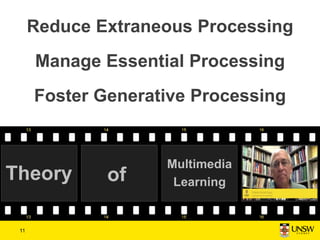Educational Film: What makes a good one and why should we care?
- 1. Educational Film: What makes a good one and why should we care?
- 2. 1 Brian Landrigan b.landrigan@unsw.edu.au @Brian_UNSW mediaUcreate
- 3. 2 Founding President of Stanford University ŌĆō 1919 ŌĆ£The educational motion picture means a revolution in pedagogy. It means vividness where vagueness has reignedŌĆØ
- 5. Research 4
- 8. 7
- 9. 8 Long Term Memory Working Memory Schemas Cognitive Load Theory
- 10. 9 Long Term Memory Working Memory Schemas Cognitive Load Theory
- 11. 10 Theory of Multimedia Learning Limited Capacity Dual Channels Active Processing
- 12. 11 Theory of Multimedia Learning Reduce Extraneous Processing Manage Essential Processing Foster Generative Processing
- 13. 12 Theory of Multimedia Learning Brame, C.J. (2015). Effective educational videos. Retrieved from http://cft.vanderbilt.edu/guide s-sub-pages/effective- educational-videos/ Process Examples Signaling: Highlighting important Information Keywords on screen highlighting important elements Changes in colour contrast to emphasise organisation of information Segmenting: Chunking the information Short Videos <6mins Chapters or click-forward questions within videos Weeding: Eliminating extraneous information Eliminating music Eliminating Complex backgrounds Matching Modality: Using the auditory and visual channels to convey complementary information Khan-style tutorial videos that illustrate and explain phenomena Narrated animations
- 14. Jack Koumi 13 Koumi, J. (2015). Learning outcomes afforded by self-assessed, segmented videoŌĆōprint combinations. http://bit.ly/2F5BivD A framework of pedagogic design principles for each chapter of the video story. Jack Koumi worked for the BBC Open University for 22 years, producing audio, video and multimedia in mathematics, science, teacher training and media design.
- 15. 14 Potent pedagogic roles for video: techniques and teaching functions enabling learning.
- 16. Tony Bates Visiting Professor of The G. Raymond Chang School of Continuing Education, Ryerson University, Toronto, Canada 15 Seeking the unique pedagogical characteristics of video http://bit.ly/2Fkgxvh
- 17. Greg Winslett Dr Greg Winslett Director, Teaching and Learning, UNE 16 What counts as educational video?: Working toward best practice alignment between video production approaches and outcomes. http://bit.ly/2I4akCu
- 18. 17 Hansch, A., Mcconachie, K., Schmidt, P., Hillers, L., Newman, C., & Schildhauer, T. (2015). The Role of Video in Online Learning: Findings From the Field and Critical Reflections. Retrieved from http://www.hiig.de/wp-content/uploads/2015/02/TopMOOC_Final-Paper.pdf
- 19. Robert Parker Postgraduate Educational Developer, Faculty of Medicine 18
- 20. 19
- 21. 20 http://bit.ly/2FwryGF Educational Video Evaluation Checklist
- 22. 21 Thoughts?






















